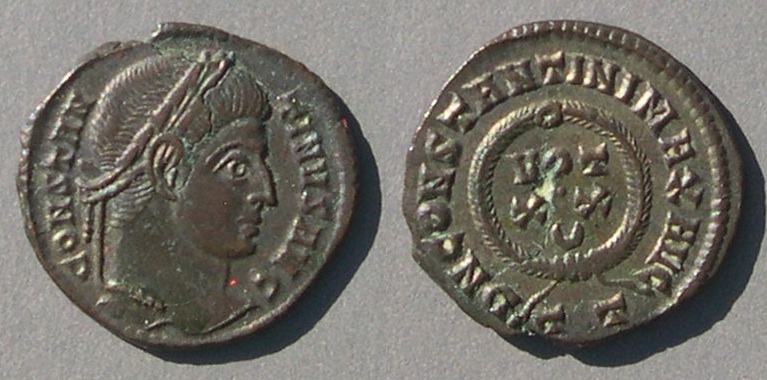 VOT X, VOT XX, and VOT XXX under Constantine
VOT X, VOT XX, and VOT XXX under Constantine
AD 320 and later.
Vota types are common under Constantine. About AD 320 there was an issue with vows for year 20 for himself and for year 5 for his sons (5-year and 15-year types are discussed on their own pages.). Although only from mints under Constantine, the issues include Licinius and Licinius II.
Constantine (306-307-337)
19 mm.
VOT/XX/upward crescent, in wreath,
DN CONSTANTINI MAX AVG around, T T below
RIC VII Ticinum 167, "322-325".
If those dates are right and the vows are soluta, the type was struck as much as three years before the VOT XX occasion. Anticipation is normal. The US celebrated its 200th anniversary in 1976, but the mint was already striking bicentennial quarters in 1975.
In that same year and following years vows for years 20 (for the Augusti) and 10 (for the sons) were issued in several types listed and illustrated next. Apparently the years record vows taken, not vows paid, and the dates of the coins are not limited to the year the vows were taken, but may continue thereafter. For example, a year-20 coin of Constantine may have been issued in year 15 (when the previous vows were fulfilled) or later. It seems in this period vows for multiples of five years were typical.
This page begins with one of each of these types (which link to additional examples for co-rulers).
1) VOT XX in a wreath with legend around (for Constantine and Licinius, below)
2) VOT X in a wreath with legend around (for Crispus, Constantine II, and Licinius II)
3) VOT XX on a standard between two captives, VIRTVS EXERCIT around (for the Augusti)
4) VOT X on a standard between two captives, VIRTVS EXERCIT around (for the Caesars)
5) VO/TIS/XX on altar with globe, stars above, BEATA TRANQVILLITAS around (Very common for Constantine, Crispus, and Constantine II. The book by Alten and Zschucke about this type lists and illustrates 179 varieties for Trier alone!)
6) VOT/XXX for Constantine only
Each of the above types is very common or common. Some have numerous bust varieties that increase the interest of collectors. The types are from mints under Constantine, not under Licinius. Nevertheless, they honor Licinius and Licinius II, however with lessor numbers of coins.
Rarer types include:
7) VO/TIS/XX, no wreath, name of augustus around, from Arles
8) VOT X/ET XV F (for Crispus, Constantine II, and Licinius II), from Rome only
9) multiples of ten years on rare fractional-denomination coins from Trier (early, c. 310)
No vota types were struck on copper after the VOT/XXX types of Constantine (c. 329) until just before the FEL TEMP REPARATIO coins reform of 348.
10) VOT/XX/MVLT/XXX struck c. 347 for Constantius II, with VOT/XV/MVLT/XX for Constans.
(The 5-year and 15-year types under Constantine have their own pages.)
Type 1) VOT XX in wreath with legend around
 [Repeated from above]
[Repeated from above]
Constantine
19 mm.
VOT/XX/upward crescent, in wreath,
DN CONSTANTINI MAX AVG around, T T below
RIC VII Ticinum 167, "322-325".
(See below for examples for Licinius.)
Type 2) VOT X in a wreath with legend around for Crispus, Constantine II, and Licinius II:
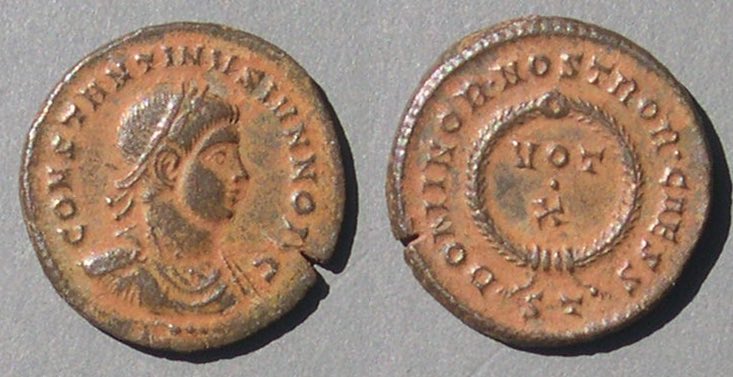 Constantine II
Constantine II
18 mm.
CONSTANTINVS IVN NOB C (Constantine Junior, Noble Caesar)
VOT/X in wreath
DOMINOR•
NOSTROR•
CAESS around
S T in exergue.RIC Ticinum 162 "r4 [But officina T is only "s"], 320-321"
(For examples of the other Caesars, see below.)
Type 2, legend variety) The next example also has VOT/X but with a different legend around.
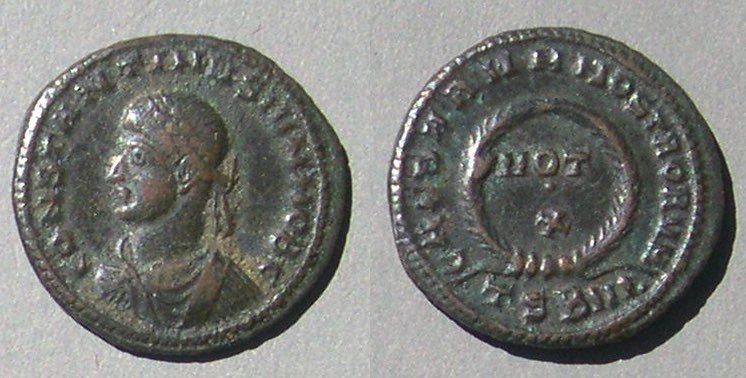 Constantine II, 324-337-340
Constantine II, 324-337-340
19 mm.
VOT X in wreath.
CAESARVM NOSTRORVM around
TSBIII in exergue
RIC Thessaloncia 128 "324"
Some "VOT X" examples are attributed by RIC to the same time period as "VOT V" examples (one is next and others are on this page)
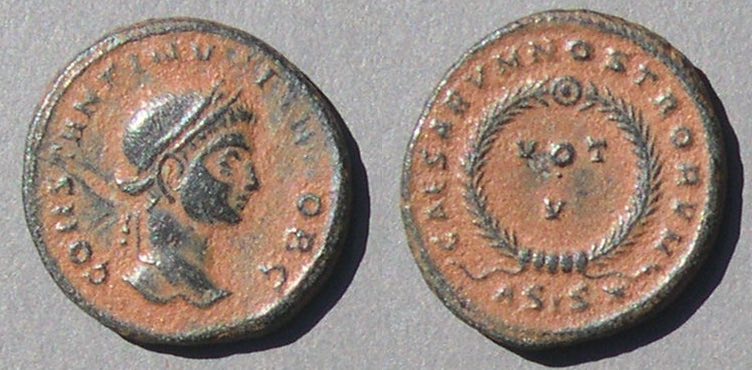 Constantine II (317-337-340). AE3. 18 mm.
Constantine II (317-337-340). AE3. 18 mm.
The reverse legend is plural:
VOT/V in wreath. CAESARVM NOSTRORVM ("our Caesars") around.
ASIS* in exergue for Siscia
RIC VII Siscia 163 struck "320-321".
Type 3) VOT XX on a standard between two captives, VIRTVS EXERCIT around (for the Augusti)
 Constantine
Constantine
18 mm.
VOT/XX on standard, two captives either side
VIRTVS EXERCIT
P T in exergue
RIC VII Ticinum 114 "c1, 319-320"
Year "XX" is appropriate for vows taken
by Constantine and Licinius 10 or 15 years into their reigns
when their would have "X". Nevertheless, there are many
"XX" coins for their sons.
(Additional examples are given below.)
Type 4) VOT X on a standard between two captives, VIRTVS EXERCIT around (for the Caesars)
 Crispus
Crispus
19 mm.
VOT/X on standard
two captives, either side
S F/HL in fields
VIRTVS EXERCITVS
ΓSIC<cresent-star>
RIC Siscia 130 "r1, 320"
Type 5) VO/TIS/XX on altar with globe, stars above, BEATA TRANQVILLITAS around
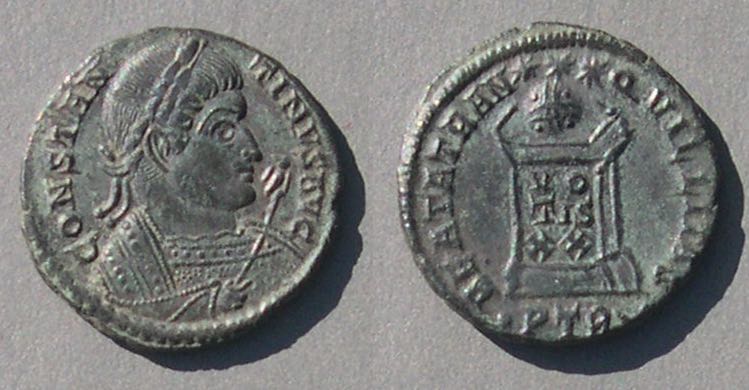 Constantine
Constantine
18 mm.
VO/TIS/XX on altar with globe, three stars above
BEATA TRAN-QVILLITAS around
•PTR• in exergue
RIC VII Trier 390 "r2 [but many related varieties], 323"
This example shows Constantine in consular robes
(which suggested it was minted in a year when he was consul)
with an eagle-tipped scepter.
(Schulten dates it to 321/2)
This basic type is very common. The book by Alten and Zschucke about this type lists and illustrates 179 varieties from Trier alone! It comes with many obverse bust varieties which make it more collectable. Here is a variety useful for dating.
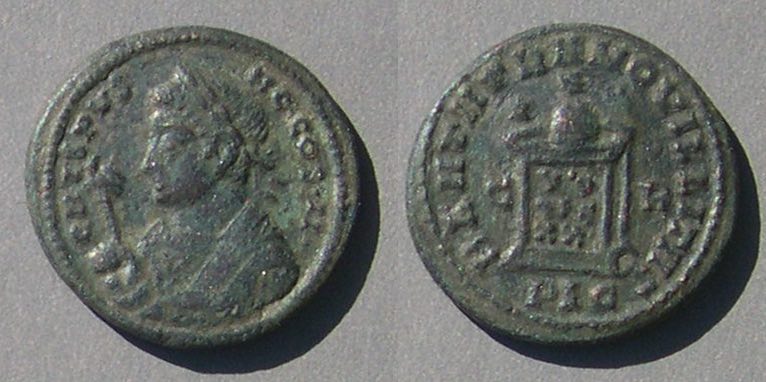 Crispus
Crispus
19 mm. 3.09 grams.
Bust left in consular robes, holding eagle-tipped scepter
CRISPVS NC COS II (which dates it to his second consulship, in 321)
VO/TIS/XX on altar with globe, three stars above
C R either side
BEATA TRAN-QVILLITAS around
PLG in exergue
RIC Lyons 138 "r4, 321"
This dated type with "COS II" is only at Lyons and only for Crispus and Constantine II. In 321 Crispus and Constantine II had not even finished 5 years, but this type has "XX." It must be a design prompted by the celebration of vows at 15 years of Constantine.
(For additional examples, see below.)
Type 6) VOT/XXX for Constantine:
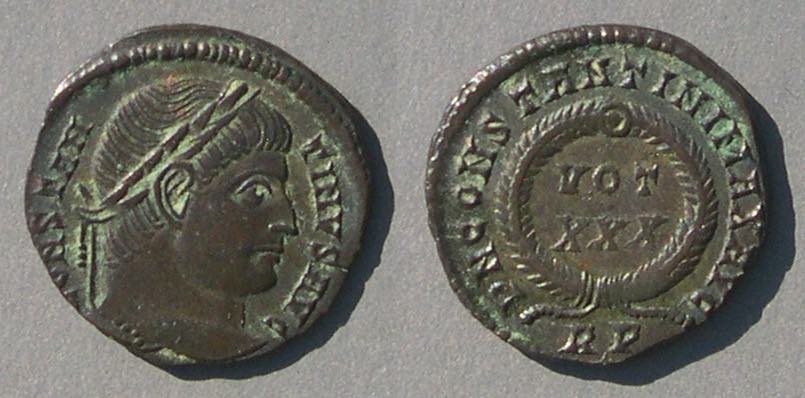 [repeated from the main vota page.]
[repeated from the main vota page.]
Constantine
VOT
XXX in wreath
CONSTANTINI MAX AVG around
R P in exergue
RIC Rome 318 "S, 329"
Vows for thirty years could have been struck anytime after the ceremony for twenty years, which would have been in 326. (For an additional example, see below.)
Type 7) The Augusti Licinius and Constantine recorded vows for 20 years:
 Constantine
Constantine
CONSTANTINI AVG around
VO/TIS/XX
P A in exergue
RIC Arles 216 "r2 [one variety, one other similar, a related type at Lyons], 320-321"
(See below for an example for Licinius)
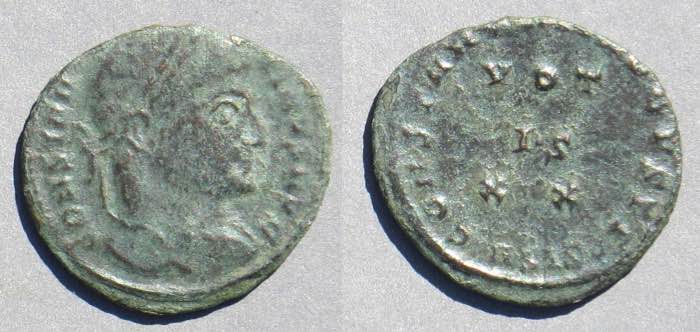
Siscia used a different legend break on a very rare variety
Constantine
VOT
IS
XX
CONSTANTINI AVGVSTI around
ASIS in exergue
RIC VII Siscia 140 "r3, 320"
Type 8) Vows for 10 and 15 years at Rome.
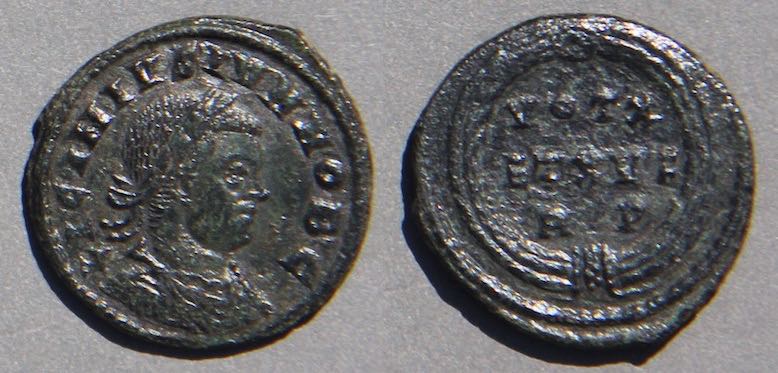
Licinius II, 317-324
19 mm. 3.14 grams.
VOT X/ET XV F "votis decennalibus et quindecennalibus felicibus"
R P
RIC VII Rome 208 "r5 [r4 for officina S), 320"
(This type is also on the year-15 page. See below for an example for Crispus)
Type 9) Fractions struck c. 310 at Trier
 Constantine, 306-307-337
Constantine, 306-307-337
13 mm (small!)
Struck 310-311 [RIC] Struck for July 25, 310 [Zschucke]
CONSTANTINVS AVG, Laureat cuirassed bust right
VO/TIS/X in wreath
RIC VI Trier 906 "R"
Zschucke 11.4 (this coin). "1/4"
(See below for more examples of fractions)
Type 10) VOT XX MVLT XXX.
After the year XXX issue (c. 329) for Constantine there was a long gap without copper vota coins. They resumed under Constantius II just prior to the FEL TEMP REPARATIO coin reform of 348.
 Constantius II.
Constantius II.
14 mm. 1.89 grams.
VOT/XX/MVLT/XXX
RIC VIII Antioch 113 struck "347-348".
Constantius II had a long reign. Made Caesar in 324, he became Augustus upon Constantine's death in 337 and ruled with brothers and cousins until 361. This type has vows for 20 years multiplied to 30 years.
John Kent (author of RIC VIII) argues that copper production shut down almost completely in 340 and was not resumed until 347 with a few types issued only shortly before the coin reform of 348 that introduced the very common FEL TEMP REPARATIO types. How can we understand the type if that date is right? I don't know.
The same issue had VOT XV for Constans. Constans was younger and had been made Caesar in 333 whereas Constantius II had been made Caesar in 324. The gap isn't five years as the coins suggest.
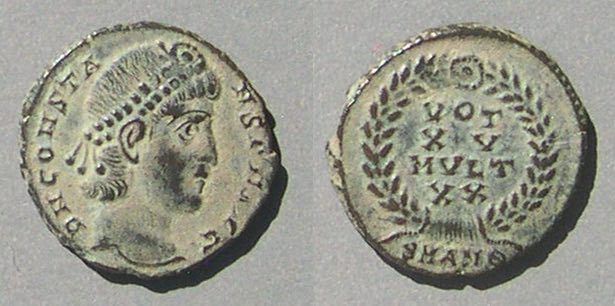 Constans
Constans
14 mm. 1.66 grams.
VOT/XV/MVLT/XX
RIC VIII Antioch 116, struck "347-348"
Both the XX and XV types are issed for each ruler, but it is much more common to find XX for Constantius II and XV for Constans.
The above coins illustrate an example of each major type of vota coin with vows for X, XX, or XXX years under Constantine. To see more coins of each type, continue on this page. Otherwise,
Continue with additional examples below.
Additional Examples.
1) Additional Examples of VOT XX in a wreath:
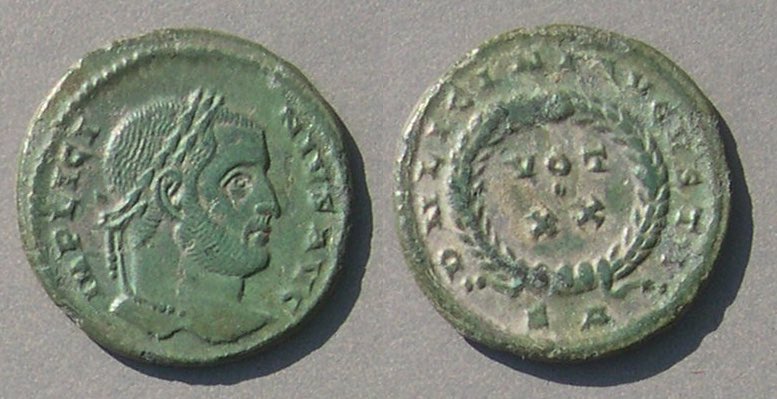 Licinius
Licinius
19 mm.
VOT/XX in wreath
DN LICINI AVGVGTI around
S A in exergue
RIC VII Arles 229 "c2, 321"
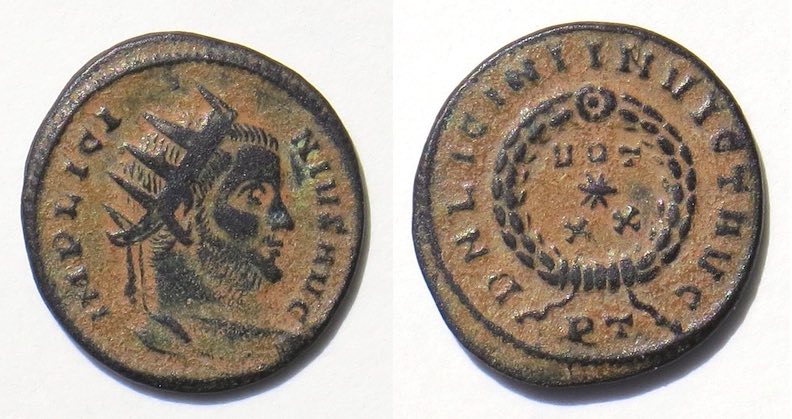 Licinius
Licinius
19 mm. 2.52 grams.
A little different because it is radiate.
VOT
✳
XX
R T in exergue
RIC VII Ticinum 154 one of three r4 varieties "320"
2) Additional examples of VOT X in a wreath with legend around
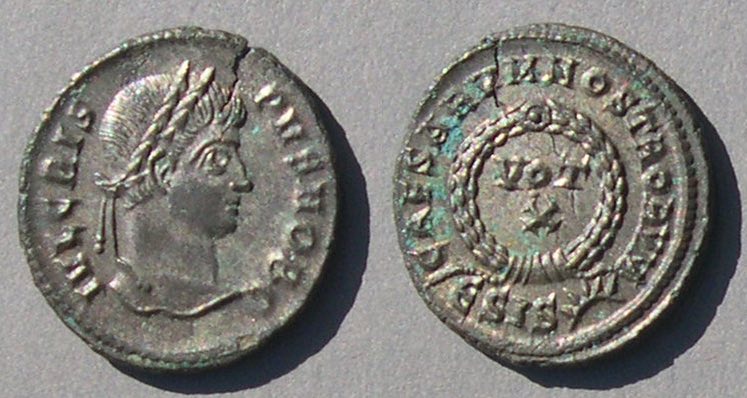
Crispus
VOT X in wreath.
CAESARVM NOSTRORVM around
ESIS<thing>
RIC Siscia 181 "c3, 321-324"
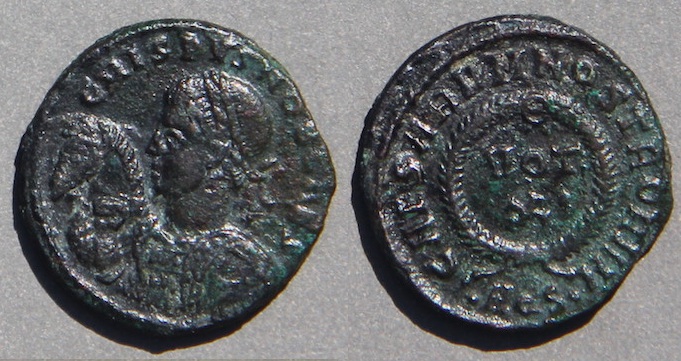 Crispus
Crispus
half-length bust of Crispus left holding horse's bridle,
horse's head left
CRISPVS NOB CAES
VOT X in wreath.
CAESARVM NOSTRORVM around
•AQS • in exergue
RIC Aquileia 98 "r3 [only one variety], 321"
Note for collectors: This variety with a horse's head on the obverse commands a very large premium. However, in general, VOT X types are very common and inexpensive.
3) Additional examples of VOT XX on a standard between two captives.
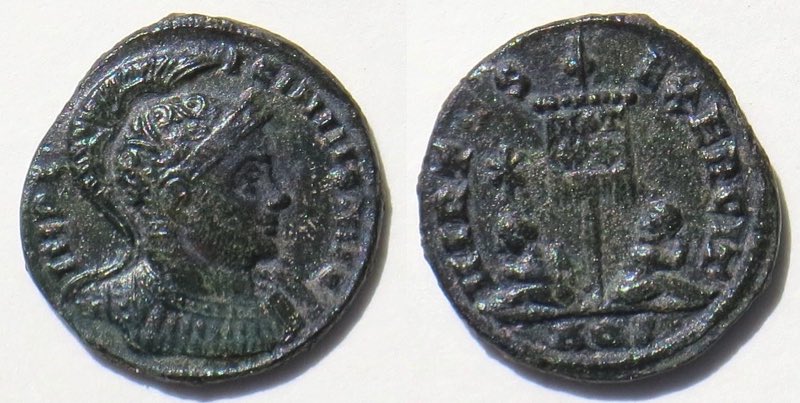 Licinius
Licinius
18 mm. 2.62 grams.
VOT/XX on standard
two captives, either side
Iota-Chi to left
VIRTVS EXERCIT around
AQS in exergue
RIC Aquileia 59 "r4, 320" [only one officina]
This variety with the Iota-Chi, which has been interpreted as an early Christian symbol, is worth more than the basic type.
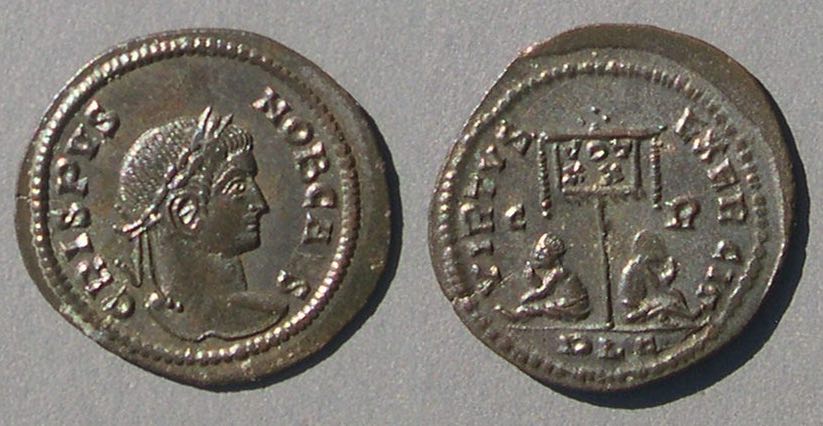 Crispus
Crispus
21 mm. 2.27 grams.
VOT/XX on standard
two captives, either side
C R in fields
VIRTVS EXERCITVS
PLG in exergue
RIC Lyons 121 "r4, 321"
This example has "XX" even though that number
is more appropriate for his father and similar coins
are issued for Crispus with "X".
4) An additional example of VOT X on a standard between two captives, VIRTVS EXERCIT around (for the Caesars)
 Licinius II
Licinius II
19 mm.
VOT/X on standard, two captives either side
S in field left, F/HL(?) in field right
VIRTVS EXERCIT
ΔSIS<crescent *>\RIC VII Siscia 132 "r1, 320"
5) Additional examples of VO/TIS/XX on altar.
BEATA TRAN-QVILLITAS coins are very common.
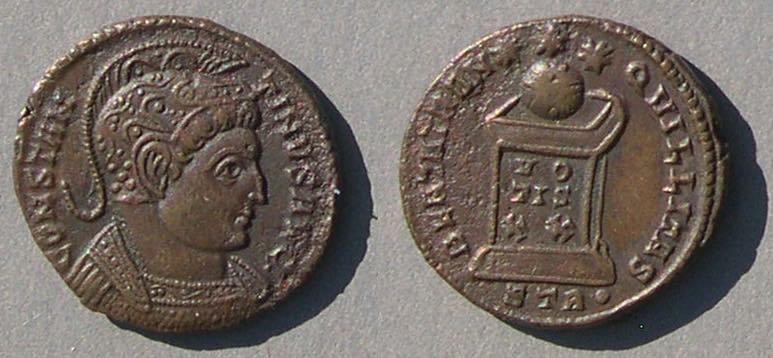 Constantine
Constantine
18 mm. 2.94 grams.
BEATA TRAN-QVILLITAS around
altar with VO/TIS/XX
globe on it and three stars above
STR• in exergue
RIC VII Trier 341 "c3, 322"
This example has Constantine wearing a fancy creasted helmet.
 Crispus
Crispus
19-17 mm. 3.12 grams.
Bust of Crispus left with spear over far shoulder
and shield with Chi-Rho. RIC Trier 372 "c3, 322-323" but
extremely rare with the chi-rho
and highly desirable as one of the first Christian types.
It would command an extremely large premium, not as a vota piece, but as an early Christian type confirming that the symbol inscribed on the shields of Constantine's soldiers at the Battle of the Milvian Bridge in 312 was a chi-rho, not a cross.
A comment for collectors. There are so many obverse varieties paired with this revere type that a lifetime of collecting could be devoted to them alone. There is a hardcover book, Die Römische Münzserie BEATA TRANQUILLITAS in der Prägestätte Trier 321-323, by Allen and Zschucke (2004) devoted to this reverse with over 500 varieties tabled and illustrated.
6) An additional example of VOT/XXX (for Constantine only)
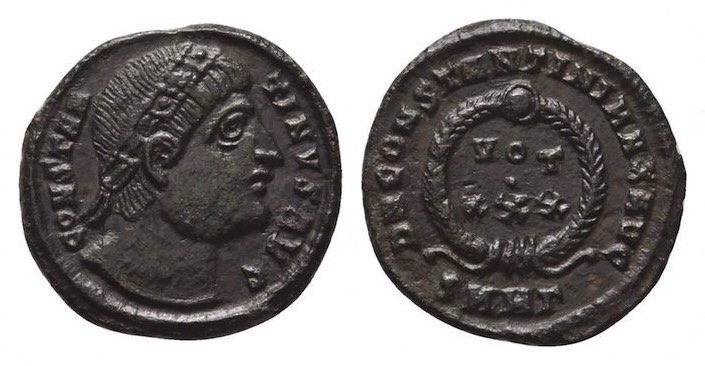
Constantine. 306-307-337.
Struck 325-326 (twenty years into his reign)
18 mm. 2.55 grams. 12:00
Reverse: VOT/XXX in wreath
DN CONSTANTINI MAX AVG around
RIC Heraclea 72v (officina Gamma unlisted)
This example is an "eyes to heaven" variety with a bust of Constantine that an ancient author recorded as Constantine looking up toward his Christian God. As such, it is of early Christian interest.
Type 7, an example for Licinius:
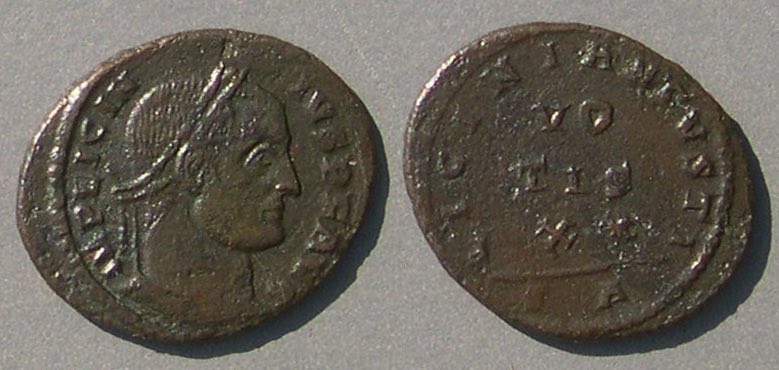
Licinius
LICINI AVGVSTA around
VO/TIS/ XX with no wreath
R A in exergue
RIC VII Arles 219 "S, 320-321"
Type 8, an example for Crispus:
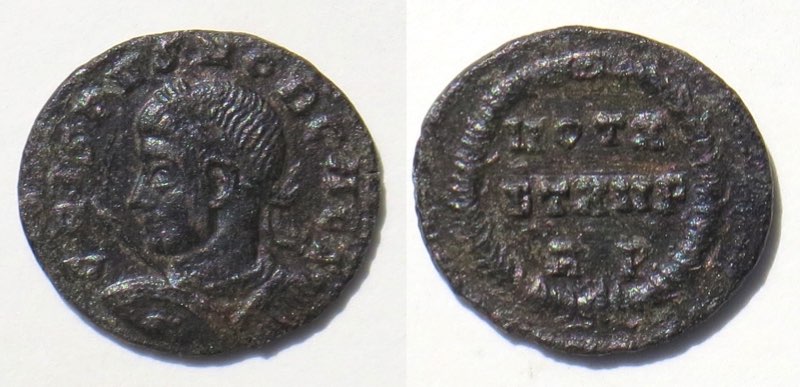 Crispus
Crispus
19-17 mm. 2.33 grams.
VOT X
ET XV F ["F" for "FEL"]
RP in wreath
RIC VII Rome 216 v [only officina S is listed, r5. This is P, unlisted] "320"
Failmezger 322
Type 9, additional examples of fractions:
 Constantine, 306-307-337
Constantine, 306-307-337
Struck for July 25, 310 [Zschucke]
13 mm. Small.
CONSTANTINVS AVG
VOT/X/MVL/XX
RIC VI Trier 913 "R2"
Zschucke 11.19-20 "1/4"
 This later fraction is from 320 under Constantine. The follis of 320 was much reduced in size from the follis of 303, so Zschucke calls this one "1/2", which is about the same size as the earlier tetrarchal "1/4."
This later fraction is from 320 under Constantine. The follis of 320 was much reduced in size from the follis of 303, so Zschucke calls this one "1/2", which is about the same size as the earlier tetrarchal "1/4."
Small. 16 mm. ("1/2" follis)
Constantine. Caesar 306-307 and Augustus 307-337.
CONSTANTINVS PF AVG
VOT/XX/MVLT/XXX in wreath
RIC -- (Thessalonica 54 is close). Zschucke, 14.11a (this coin), attributes it to July 25, 320, for the quinquennalia (15-year celebration) of Constantine.
If that date is right, it appears that five-year intervals had come into use, so "VOT XX MVLT XXX" could mean "vows for 20 and 30 years taken (suscepta)." We know that Constantine did celebrate fifteen years, so it is possible this coin was issued for the 15-year festival.
References: RIC VII is the main reference, by far.
Alten, Dieter and Carl-Friedrich Zschucke. Die Romische Munzserie BEATA TRANQVILLITAS in der Pragestatte Trier 321-323. Hardcover, 1987. 148 pages. 170 varieties, all photographed, plus many tables, line drawings and closeup photographs of details such as shield designs.
Schulten, Peter N. Die Romische Munzstatte Trier. Paperback. 1974. 52 pages and 10 page plates.
Continue with the page of vota coins of Magnentius and Decentius.
Return to the main Vota page.
Leave the vota pages and go to the main Table of Contents page for this entire educational site.
 VOT X, VOT XX, and VOT XXX under Constantine
VOT X, VOT XX, and VOT XXX under Constantine  Constantine II
Constantine II Constantine II, 324-337-340
Constantine II, 324-337-340 Constantine II (317-337-340). AE3. 18 mm.
Constantine II (317-337-340). AE3. 18 mm.  Constantine
Constantine Crispus
Crispus Constantine
Constantine Crispus
Crispus [repeated from the main vota page.]
[repeated from the main vota page.] Constantine
Constantine

 Constantine, 306-307-337
Constantine, 306-307-337 Constantius II.
Constantius II. Constans
Constans Licinius
Licinius Licinius
Licinius
 Crispus
Crispus Licinius
Licinius Crispus
Crispus Licinius II
Licinius II Constantine
Constantine Crispus
Crispus

 Crispus
Crispus Constantine, 306-307-337
Constantine, 306-307-337 This later fraction is from 320 under Constantine. The follis of 320 was much reduced in size from the follis of 303, so Zschucke calls this one "1/2", which is about the same size as the earlier tetrarchal "1/4."
This later fraction is from 320 under Constantine. The follis of 320 was much reduced in size from the follis of 303, so Zschucke calls this one "1/2", which is about the same size as the earlier tetrarchal "1/4."